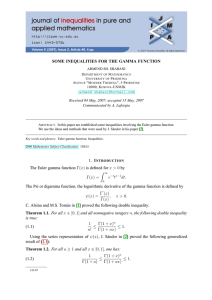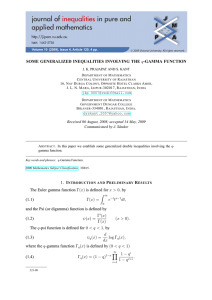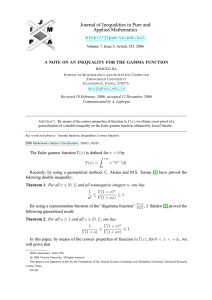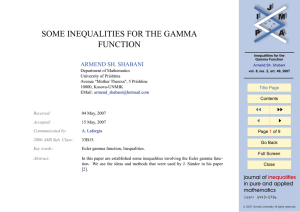SOME INEQUALITIES FOR THE Communicated by J. Sándor
advertisement
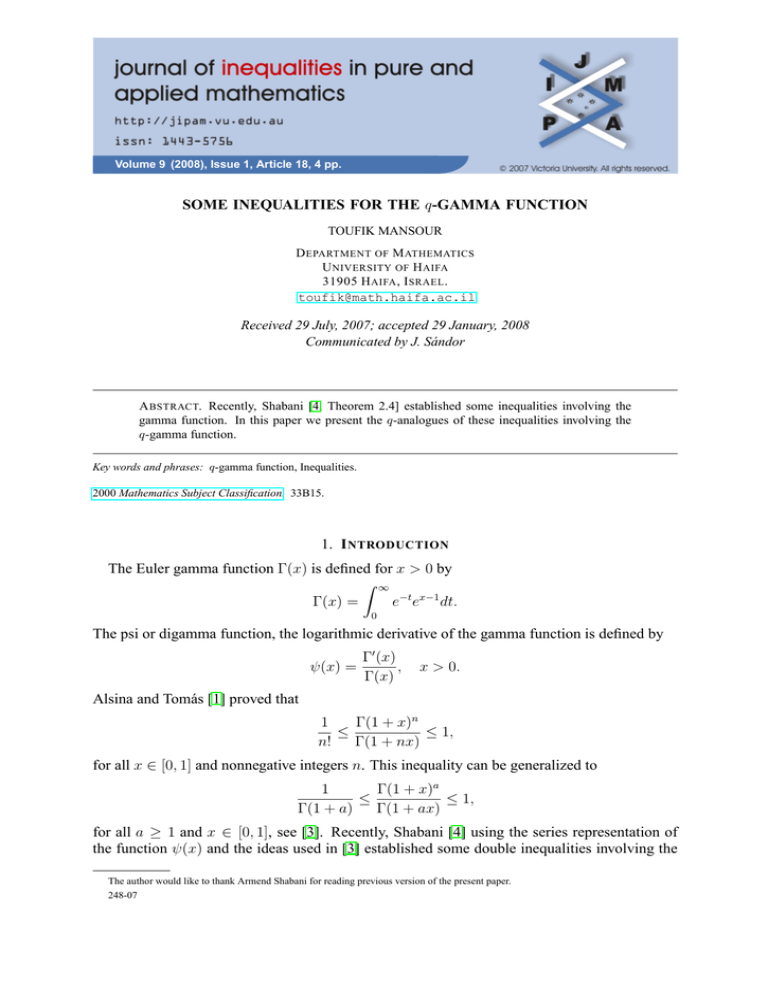
Volume 9 (2008), Issue 1, Article 18, 4 pp. SOME INEQUALITIES FOR THE q-GAMMA FUNCTION TOUFIK MANSOUR D EPARTMENT OF M ATHEMATICS U NIVERSITY OF H AIFA 31905 H AIFA , I SRAEL . toufik@math.haifa.ac.il Received 29 July, 2007; accepted 29 January, 2008 Communicated by J. Sándor A BSTRACT. Recently, Shabani [4, Theorem 2.4] established some inequalities involving the gamma function. In this paper we present the q-analogues of these inequalities involving the q-gamma function. Key words and phrases: q-gamma function, Inequalities. 2000 Mathematics Subject Classification. 33B15. 1. I NTRODUCTION The Euler gamma function Γ(x) is defined for x > 0 by Z ∞ Γ(x) = e−t ex−1 dt. 0 The psi or digamma function, the logarithmic derivative of the gamma function is defined by Γ0 (x) ψ(x) = , Γ(x) x > 0. Alsina and Tomás [1] proved that 1 Γ(1 + x)n ≤ ≤ 1, n! Γ(1 + nx) for all x ∈ [0, 1] and nonnegative integers n. This inequality can be generalized to 1 Γ(1 + x)a ≤ ≤ 1, Γ(1 + a) Γ(1 + ax) for all a ≥ 1 and x ∈ [0, 1], see [3]. Recently, Shabani [4] using the series representation of the function ψ(x) and the ideas used in [3] established some double inequalities involving the The author would like to thank Armend Shabani for reading previous version of the present paper. 248-07 2 T OUFIK M ANSOUR gamma function. In particular, Shabani [4, Theorem 2.4] proved (1.1) Γ(a)c Γ(a + bx)c Γ(a + b)c ≤ ≤ , Γ(b)d Γ(b + ax)d Γ(a + b)d for all x ∈ [0, 1], a ≥ b > 0, c, d are positive real numbers such that bc ≥ ad > 0, and ψ(b + ax) > 0. In this paper we give the q-inequalities of the above results by using similar techniques to those in [4]. The main ideas of Shabani’s paper, as well as of the present one, are contained in paper [3] by Sándor. More precisely, we define the q-psi function as (0 < q < 1) d ψq (x) = log Γq (x), dx where the q-gamma function Γq (x) is defined by (0 < q < 1) Γq (x) = (1 − q)1−x ∞ Y 1 − qi . x+i 1 − q i=1 Many properties of the q-gamma function were derived by Askey [2]. The explicit form of q-psi function ψq (x) is (1.2) ψq (x) = − log(1 − q) + log q ∞ X i=0 q x+i . 1 − q x+i In this paper we extend (1.1) to the case of Γq (x). In particular, by using the facts that limq→1− Γq (x) = Γ(x) and limq→1− ψq (x) = ψ(x) we obtain all the results of Shabani [4]. 2. M AIN R ESULTS In order to establish the proof of the theorems, we need the following lemmas. Lemma 2.1. Let x ∈ [0, 1], q ∈ (0, 1), and a, b be any two positive real numbers such that a ≥ b. Then ψq (a + bx) ≥ ψq (b + ax). Proof. Clearly, a + bx, b + ax > 0. The series presentation of ψq (x), see (1.2), gives ∞ X q a+bx+i q b+ax+i ψq (a + bx) − ψq (b + ax) = log q − 1 − q a+bx+i 1 − q b+ax+i i=0 = log q = log q ∞ X i=0 ∞ X i=0 q i (q a+bx − q b+ax ) (1 − q a+bx+i )(1 − q b+ax+i ) q b+bx+i (q a−b − q (a−b)x ) . (1 − q a+bx+i )(1 − q b+ax+i ) Since 0 < q < 1 we have that log q < 0. In addition, since a ≥ b we get that q a−b ≤ q (a−b)x . Hence, ψq (a + bx) − ψq (b + ax) ≥ 0, which completes the proof. Lemma 2.2. Let x ∈ [0, 1], q ∈ (0, 1), a, b be any two positive real numbers such that a ≥ b and ψq (b + ax) > 0. Let c, d be any two positive real numbers such that bc ≥ ad > 0. Then bcψq (a + bx) − adψq (b + ax) ≥ 0. J. Inequal. Pure and Appl. Math., 9(1) (2008), Art. 18, 4 pp. http://jipam.vu.edu.au/ I NEQUALITIES FOR THE q-G AMMA F UNCTION 3 Proof. Lemma 2.1 together with ψq (b + ax) > 0 give that ψq (a + bx) > 0. Thus Lemma 2.1 obtains bcψq (a + bx) ≥ adψq (a + bx) ≥ adψq (b + ax), as required. Now we present the q-inequality of (1.1) . Theorem 2.3. Let x ∈ [0, 1], q ∈ (0, 1), a ≥ b > 0, c, d positive real numbers with bc ≥ ad > 0 and ψq (b + ax) > 0. Then Γq (a)c Γq (a + bx)c Γq (a + b)c ≤ ≤ . Γq (b)d Γq (b + ax)d Γq (a + b)d Proof. Let f (x) = Γq (a+bx)c Γq (b+ax)d and g(x) = log f (x). Then g(x) = c log Γq (a + bx) − d log Γq (b + ax), which implies that d g(x) dx Γ0q (a + bx) Γ0q (b + ax) = bc − ad Γq (a + bx) Γ(b + ax) = bcψq (a + bx) − adψq (b + ax). g 0 (x) = Thus, Lemma 2.2 gives g 0 (x) ≥ 0, that is, g(x) is an increasing function on [0, 1]. Therefore, f (x) is an increasing function on [0, 1]. Hence, for all x ∈ [0, 1] we have that f (0) ≤ f (x) ≤ f (1), which is equivalent to Γq (a + bx)c Γq (a + b)c Γq (a)c ≤ ≤ , Γq (b)d Γq (b + ax)d Γq (a + b)d as requested. Similarly as in the argument proofs of Lemmas 2.1 – 2.2 and Theorem 2.3 we obtain the following results. Lemma 2.4. Let x ≥ 1, q ∈ (0, 1), and a, b be any two positive real numbers with b ≥ a. Then ψq (a + bx) ≥ ψq (b + ax). Lemma 2.5. Let x ≥ 1, q ∈ (0, 1), a, b be any two positive real numbers with b ≥ a and ψq (b + ax) > 0, and c, d be any two real numbers such that bc ≥ ad > 0. Then bcψq (a + bx) − adψq (b + ax) ≥ 0. Using similar techniques to the ones in the proof of Theorem 2.3 with Lemmas 2.4 and 2.5, instead of Lemmas 2.1 and 2.2, we can prove the following result. Theorem 2.6. Let x ≥ 1, q ∈ (0, 1), a, b be any two positive real numbers with b ≥ a > 0 and (a+bx)c ψq (b + ax) > 0, and c, d be any two real numbers such that bc ≥ ad > 0. Then ΓΓqq (b+ax) d is an increasing function on [1, +∞). In addition, similar arguments as in the proof of Lemma 2.2 will obtain the following lemmas. Lemma 2.7. Let x ∈ [0, 1], q ∈ (0, 1), a, b be any two positive real numbers with a ≥ b > 0 and ψq (a + bx) < 0, and c, d be any two real numbers such that ad ≥ bc > 0. Then bcψq (a + bx) − adψq (b + ax) ≥ 0. J. Inequal. Pure and Appl. Math., 9(1) (2008), Art. 18, 4 pp. http://jipam.vu.edu.au/ 4 T OUFIK M ANSOUR Lemma 2.8. Let x ≥ 1, q ∈ (0, 1), a, b be any two positive real numbers with b ≥ a and ψq (a + bx) < 0, and c, d be any two real numbers such that ad ≥ bc > 0. Then bcψq (a + bx) − adψq (b + ax) ≥ 0. Using similar techniques to the ones in the proof of Theorem 2.3, with Lemmas 2.2 and 2.7, we obtain the following. Theorem 2.9. Let x ∈ [0, 1], q ∈ (0, 1), a, b be any two positive real numbers with a ≥ b > 0 (a+bx)c and ψq (a + bx) < 0, and c, d be any two real numbers such that ad ≥ bc > 0. Then ΓΓqq (b+ax) d is an increasing function on [0, 1]. Using similar techniques to the ones in the proof of Theorem 2.3, with Lemmas 2.4 and 2.8, we obtain the following. Theorem 2.10. Let x ≥ 1, q ∈ (0, 1), a, b be any two positive real numbers with b ≥ a > 0 and (a+bx)c ψq (a + bx) < 0, and c, d be any two real numbers such that ad ≥ bc > 0. Then ΓΓqq (b+ax) d is an increasing function on [1, +∞). R EFERENCES [1] A. ALSINA AND M.S. TOMÁS, A geometrical proof of a new inequality for the gamma function, J. Ineq. Pure Appl. Math., 6(2) (2005), Art. 48. [ONLINE: http://jipam.vu.edu.au/ article.php?sid=517]. [2] R. ASKEY, The q-gamma and q-beta functions, Applicable Anal., 8(2) (1978/79), 125–141. [3] J. SÁNDOR, A note on certain inequalities for the gamma function, J. Ineq. Pure Appl. Math., 6(3) (2005), Art. 61. [ONLINE: http://jipam.vu.edu.au/article.php?sid=534]. [4] A. Sh. SHABANI, Some inequalities for the gamma function, J. Ineq. Pure Appl. Math., 8(2) (2007) Art. 49. [ONLINE: http://jipam.vu.edu.au/article.php?sid=852]. J. Inequal. Pure and Appl. Math., 9(1) (2008), Art. 18, 4 pp. http://jipam.vu.edu.au/


